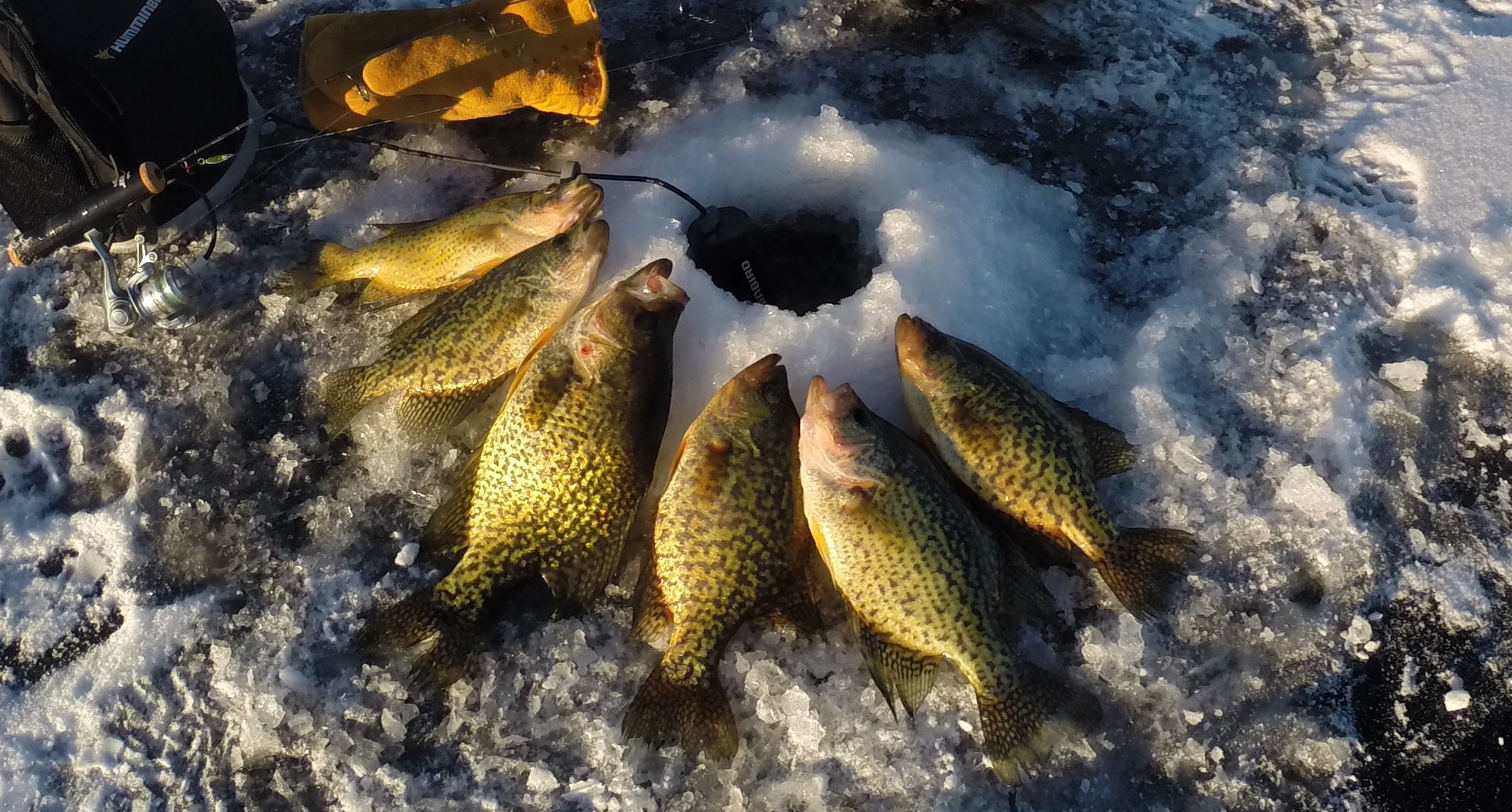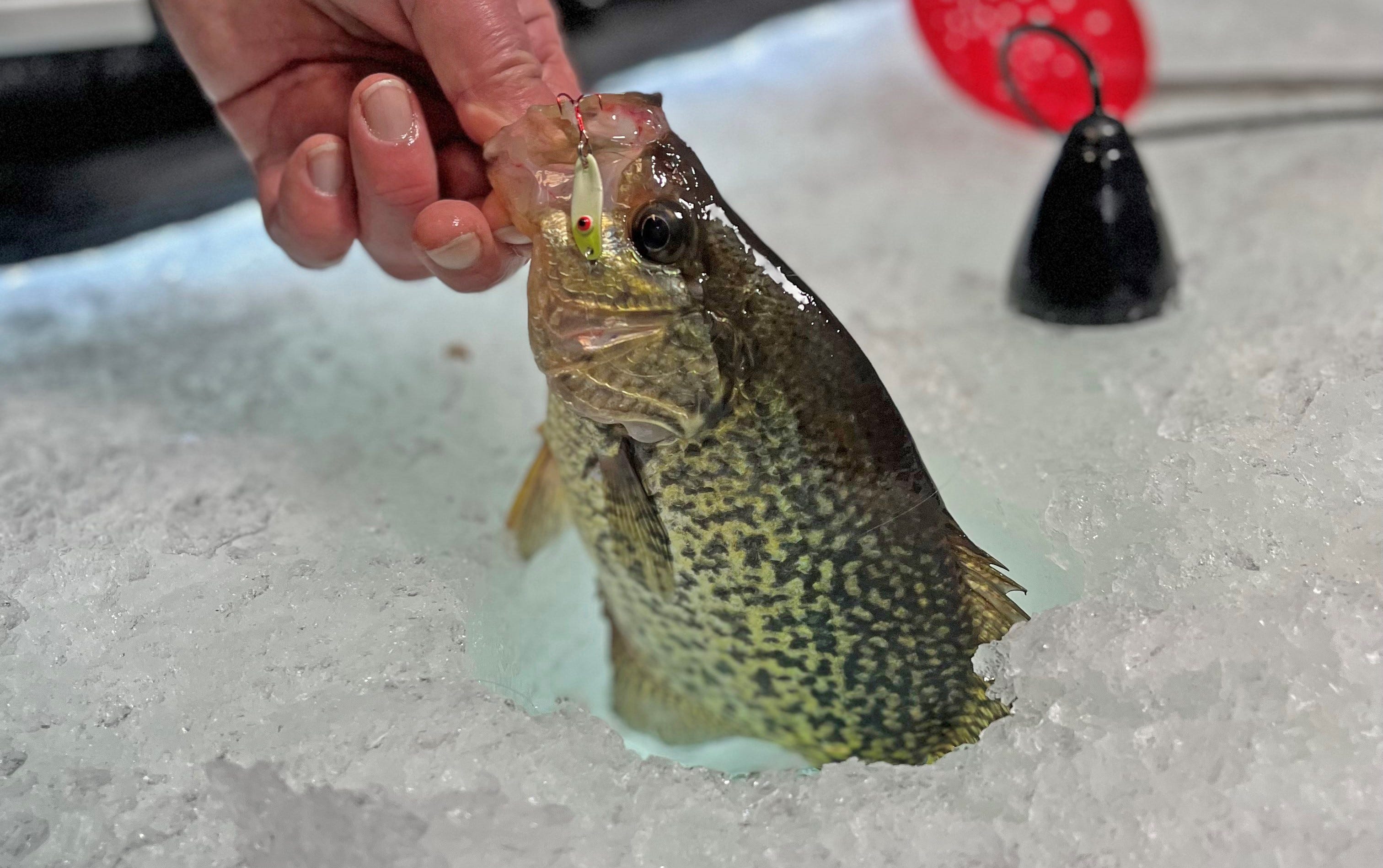- Jan 19, 2023
Overlooked Ice Crappie Spoon Strategies
As winter progresses, ice fishing spoons become increasingly valuable for drawing crappie near and triggering strikes. Learn to how spoons can increase your crappie catches through the heart of winter.
Ice fishing spoons are highly popular lures, but many anglers mostly turn to these flashy offerings when they are fishing for walleyes, sauger, pike and trout. Ice fishing for crappies is more commonly associated with jigs – the same ice jigs used for bluegills and perch. Spoons have major value as crappie lures, though, and that value increases through the heart of winter.
We’ll explain why ice fishing spoons become extra important as winter progresses, look at the best spoon presentations and strategies when you are ice fishing for crappies, and highlight a few excellent ice spoons.
Ice Fishing Spoon Virtues
While a well-presented jig has undeniable virtue for crappies and at times is the best lure choice, during mid-winter and continuing through the latter part of winter, ice fishing spoons become very important and often will outproduce other type of lures.
During mid-winter, after shallow vegetation has died and crappies have begun migrating toward deeper holes, the fish commonly cruise flats between weedy areas and the holes where they will spend the coldest part of winter and move to the edges of the same holes. These fish don’t tend to be concentrated, and they roam a lot. That means you can’t just find an edge that is loaded with fish and set up atop them. The crappies often need to find you. Spoons send out flash and vibration and in the case of rattling spoons, sound, to draw roaming fish close.
As winter continues its progression, snow cover thickens and the fish move farther down into deep holes, again reducing visibility and increasing the need for extra vibration and sound. They also tend to roam broad areas in holes, as opposed to holding on defined edges.
“When the fish are roaming and when visibility is reduced, using a bait that makes more noise can make a big difference,” said Destination Fish host Jon Thelen.
While Thelen likes a jig and bait early in the season, when the crappies are shallow and feeding on more aquatic insects, the deeper holes hold big numbers of baitfish, so he relies more on spoons to “match the hatch” later in the winter.
Thelen favors rattling spoons during mid- and late winter, and he often chooses larger sizes than many anglers associate with crappie fishing. If he is fishing in waters that produce big crappies, he’ll often select a 1/8-ounce Rattl’n Flyer Spoon or Rattl’n Quiver Spoon, instead of the 1/16-ounce size.
Crappies have larger mouths than other panfish, and they feed on larger forage than many anglers realize.
Ice Crappie Spoon Presentation Tips
Crappies tend to get fussier as winter progresses, both because plentiful forage tends to be nearby and because extreme cold slows metabolism rates and reduces the fish’s need to feed as frequently. What that means from a practical standpoint is that finding the fish and choosing the right lure are only part of the challenge. You must experiment with presentations and pay attention to the crappies’ reactions.
“You have to figure out what trips their trigger any given day,” Thelen said. “How aggressive a cadence?”
Rattling spoon presentations might include upward sweeps that allow the lure to wobble back down, hard shakes to engage the rattles, shorter or softer jigging motions, subtle quivering of the rod tip and pauses. Often, triggering bites calls for some combination of basic motions, so you need to figure out the right combination and subtleties like the right sharpness of motions and the lengths of pauses.
It’s also worth noting that mid-winter crappie catching success sometimes demands persistence. A crappie might watch a bait for a l-o-n-g time before committing. Don’t give up on a fish too quickly. If it stays around, it’s interested. You just have to figure out how to coax the strike!
A final presentation consideration that will help you catch more of the fish that show interest is to keep your bait above them. Crappies’ eyes are high on their heads. Consequently, even more so than most other species, they prefer to feed up. If you can get them to chase your bait upward, they are very close to committing. If your spoon drops beneath a crappie, that fish will often flee.
Watch the Whole Water Column


No matter how deep the bottom is, crappies might be swimming at any depth. Unlike bluegills, which use the bottom for concealment and typically stay within a few feet of the bottom, crappies use the entire water column.
Keep a constant eye your electronics. If fish repeatedly showing up at a certain depth, that could be the depth most crappies are using that day. Spend some time with you spoon at that depth or two or three feet higher in the water column.
Whether or not you notice high fish, if you are not catching as many fish as you think you should be or if you are catching mostly bluegills or perch but want to catch crappie, try fishing higher in the water column. When you do catch fish, always take note of how deep your bait was when the fish hit. Crappie can be very depth specific, and any given day they might all be 17 to 20 feet deep, whether the bottom depth is 25 feet or 40 feet.
If you’re fishing without electronics, start with your spoon working near the bottom and occasionally reel one or two cranks and go back to jigging. Keep a count in your head, and if you lose track, drop it back to the bottom and reel a known number of handle turns. That’s important to track so you know the depth to return to after you catch a fish.
3 Top Ice Fishing Spoons for Crappies


Rattl’n Flyer Spoon – A Lindy Classic, the Rattl’n Flyer Spoon moves with a hard erratic wobble and will swing outside the hole to help you work a bigger area, and it rattles loudly. This ice spoon comes in a dozen colors and four sizes, with the 1/8- and 1/16-ounce models being the primary picks for crappie.
Rattl’n Quiver Spoon – A lightweight spoon with a slow, wobbling fall and a slender profile, The Rattl’n Quiver Spoon coaxes strikes from fussy fish. The single-ball rattle sounds off rhythmically when the lure is falling through the water column. The Rattl’n Quiver Spoon comes in three sizes – 1/16-, 1/8- and 1/4-ounce – and eight colors.
Glow Spoon – The Glow Spoon becomes extra valuable as winter deepens and snow coverage increases. Along with being equipped with loud tungsten rattles, this spoon uses special glow sticks to light up, dramatically increasing visibility in dark areas. The Glow Spoon comes in three sizes and 16 colors.



